![]()
![]()
![]()
Use LEFT and RIGHT arrow keys to navigate between flashcards;
Use UP and DOWN arrow keys to flip the card;
H to show hint;
A reads text to speech;
61 Cards in this Set
- Front
- Back
|
In a phyllodes tumor the breast, what is the usual mitotic rate found in a borderline tumor?
A. <10 mitoses/10 hpf B. 5-10 mitoses/10 hpf C. 10-20 mitoses/10 hpf D. 10-<20 mitoses/50 hpf E. 5-10 mitoses/50 hpf |
B. A borderline phyllodes tumor is characterized by 5-10 mitoses/10 hpf.
|
|
|
All of the following are positive in pseudo-angiomatous stromal hyperplasia EXCEPT:
A. Vimentin B. Actin C. CD34 D. CD31 E. All the above are positive |
D. CD31 is not positive in pseudo-angiomatous stromal hyperplasia. The nucleated cells of
pseudo-angiomatous stromal hyperplasia are thought to be myofibroblastic in origin. |
|
|
All the following are associated with fibromatosis of the breast EXCEPT:
A. Pregnancy B. Neurofibromatosis type 1 C. Trauma D. Gardner syndrome |
B. Fibromatosis of the breast has been associated with trauma, pregnancy, and Gardner syndrome.
|
|
|
The malignant cells and Paget's disease may stain with all of the following EXCEPT:
A. EMA B. CEA C. High molecular weight cytokeratins D. PAS E. ER/PR |
C. Paget's cells are malignant glandular cells and will stain with low molecular weight cytokeratins
(characteristic of glandular epithelium) but not high molecular weight cytokeratins (positive in squamous epithelium -- CK5/6). PAS will often highlight diastase resistant mucin globules. |
|

An irregular breast mass was found on self examination by a 46-year-old female. A FNA was
performed and representative images are shown for this case, which highlight cells with atypical cytology that are discohesive and in a clean background. What is the best diagnosis? A. Fibroadenoma B. Medullary carcinoma C. Lymphoma D. Invasive breast cancer E. None of the above |
Invasive breast cancer; atypia along with the discohesive features are
suggestive of carcinoma the background is clean, which is unlike a fibroadenoma which will have numerous naked nuclei medullary carcinoma would have a significant infiltrate of lymphoid cells. |
|
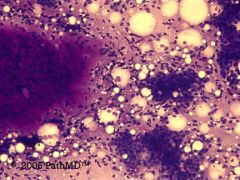
During pregnancy a 36-year-old female noted an enlarging breast mass 4 cm in greatest
dimension. A FNA was performed and representative cytologic images are shown. Based on these findings, what is the best diagnosis? A. Fibroadenoma B. Medullary carcinoma C. Lymphoma D. Invasive breast cancer E. None of the above |
A. This case shows the cytologic features classic in a fibroadenoma. groups of cohesive cells with a “staghorn” configuration, stromal elements, and numerous naked nuclei in the
background |
|
|
After fibroadenoma, what is the most common focal mass lesion of the breast?
A. Papilloma B. DCIS C. Fibrocystic Disease D. Phyllodes tumor E. Sclerosing adenosis |
Papillomas are only second to fibroadenomas as the most common mass lesion in the breast.
Fibrocystic disease/change is very common, but does not usually result in a focal mass lesion. |
|
|
All the following are true with regards to fibroadenomas EXCEPT:
A. More common in Afro-Caribbean women B. The most common mass lesion in the breast C. Most common in women in their 20s-30s D. Are differentiated from fibroadenomatoid hyperplasia by the presence of a capsule |
D. Fibroadenomas are discrete masses, but do not have a capsule.
|
|
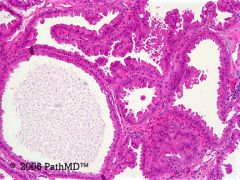
Multiple masses are noted in the breast of a 40-year-old female. To reassure the patient, an
excision was performed and a representative image of the histology is shown. Based on these findings, what is the best diagnosis? A. Fibrocystic changes B. Ductal carcinoma in situ with apocrine change C. Apocrine carcinoma D. Elongated a lobular units with columnar cell alteration (ELUCA) E. None of the above |
A. This case illustrates the common finding of apocrine metaplasia, which is a feature of
fibrocystic change. |
|

Mammary glands are surrounded by concentric slits lined by CD34 positive cells.
Immunohistochemistry: CD34+, Calponin+, CD31- Women 19-52 years; also common in men with gynecomastia |
Pseudoangiomatous stromal hyperplasia (PASH) of breast
|
|
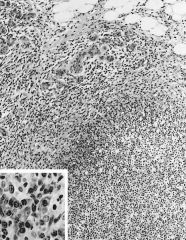
Considered a variant of periductal mastitis/duct ectasia with prominent plasma cell component
Associated with pregnancy, occurs a mean 4 years after cessation of lactation Resembles carcinoma clinically |
Plasma cell mastitis
|
|
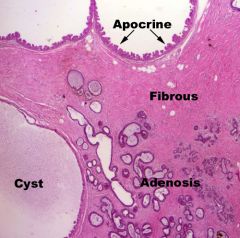
Associated with hormonal imbalance (increased estrogen to progesterone ratio); decreased risk with oral contraceptives, perhaps due to balanced supply of estrogens and progesterone
Either proliferative (adenosis, hyperplasia) or nonproliferative (cysts) |
Fibrocystic disease of breast - general
|
|
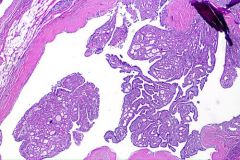
Central (large duct): close to nipple within principal lactiferous ducts, 90% solitary, 70% associated with nipple discharge; usually ages 30-49 years but any age
Peripheral: often clinically occult, discovered by mammographic calcifications; usually multiple |
Papilloma of breast
|
|

|
Granular cell tumor of breast
Positive stains: PAS (diastase resistant), S100, CD68 (due to phagolysosomes), focal CEA and vimentin Negative stains: keratin, EMA, mucin, alpha-1-antitrypsin, myoglobin, ER, PR |
|
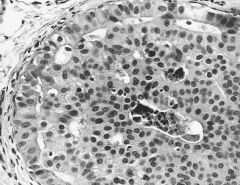
neoplastic intraductal lesion with architectural and cytological features suggestive but not diagnostic of low grade DCIS
|
Atypical ductal hyperplasia (ADH) of breast
|
|
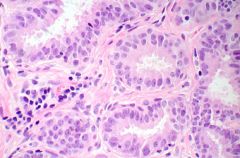
|
Adenosis of breast
|
|
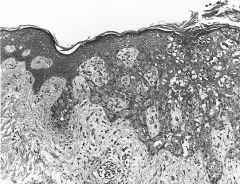
malignant epithelial cells randomly disposed within epidermis of nipple areola; a type of in situ carcinoma that arises in/involves main excretory (lactiferous) ducts
Present in 1-2% of all patients with breast carcinoma, median age 54 years |
Paget’s disease
|
|
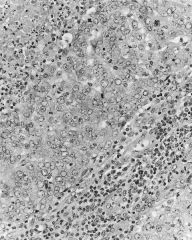
well circumscribed, composed of poorly differentiated cells in syncytia or large sheets, with prominent lymphoplasmacytic infiltrate, scant fibrous stroma, no glandular structures, minimal DCIS
Uncommon, <1% of invasive breast carcinomas Usually < 50 years old, often < 35 years old, common in Japanese, associated with BRCA1 mutations |
Medullary carcinoma
Positive stains: CK 5/6 (94%), p53 (77%); also high Ki-67 index, HLA-DR, S100 Negative stains: ER, PR, HER2 amplification |
|
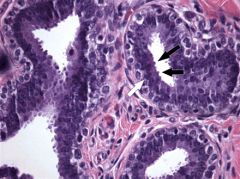
|
Columnar cell lesion of breast
|
|
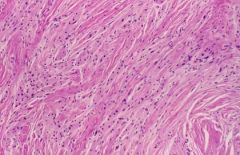
tumor whose cells have granular eosinophilic cytoplasm and bland small nuclei
More common in women in 40’s; may be more common in African-American women Resembles invasive carcinoma clinically, but almost always benign Appears to derive from Schwann cells of peripheral nerves (at all sites) |
Granular cell tumor of breast
Positive stains: PAS (diastase resistant), S100, CD68 (due to phagolysosomes), focal CEA and vimentin Negative stains: keratin, EMA, mucin, alpha-1-antitrypsin, myoglobin, ER, PR |
|
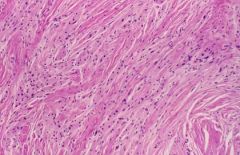
tumor whose cells have granular eosinophilic cytoplasm and bland small nuclei
More common in women in 40’s; may be more common in African-American women Resembles invasive carcinoma clinically, but almost always benign Appears to derive from Schwann cells of peripheral nerves (at all sites) |
Granular cell tumor of breast
Positive stains: PAS (diastase resistant), S100, CD68 (due to phagolysosomes), focal CEA and vimentin Negative stains: keratin, EMA, mucin, alpha-1-antitrypsin, myoglobin, ER, PR |
|
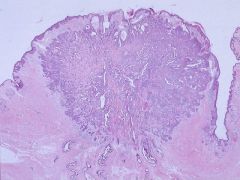
compact proliferation of small tubules lined by epithelial and myoepithelial cells, near collecting ducts of nipple
Uncommon benign variant of intraductal papilloma involving terminal portion of ducts Age 30-49 years, unilateral, associated with serous/bloody nipple discharge May clinically resemble Paget’s disease of nipple |
Nipple adenoma / florid papillomatosis of nipple
|
|

|
Pseudoangiomatous stromal hyperplasia (PASH) of breast
Positive stains: spindle cells - PR (intense, AJSP 1991;15:145), vimentin, CD34 (AJSP 1995;19:270); variable desmin and actin Negative stains: spindle cells - Factor VIII, Ulex, CD31, ER, keratin |
|
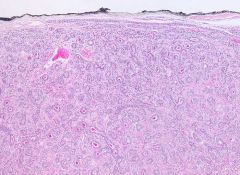
benign nodules formed by the compact proliferation of tubular structures with 2 cell layers
Rare; usually young women, occasionally older women Case reports: 26 year old woman with 4 cm mass |
Positive stains: epithelial cells - EMA, ER, PR; myoepithelial cells - smooth muscle actin, vimentin
|
|
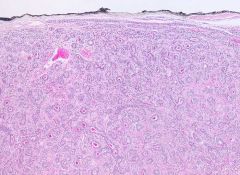
benign nodules formed by the compact proliferation of tubular structures with 2 cell layers
Rare; usually young women, occasionally older women Case reports: 26 year old woman with 4 cm mass |
Positive stains: epithelial cells - EMA, ER, PR; myoepithelial cells - smooth muscle actin, vimentin
|
|

|
Atypical ductal hyperplasia (ADH) of breast
neoplastic intraductal lesion with architectural and cytological features suggestive but not diagnostic of low grade DCIS Also called DIN 1B Increased risk of carcinoma in pre- or post-menopausal women of 4 to 5x, equal in both breasts; risk is 10x if first degree relative has breast cancer |
|

Rare myoepithelial cells with small dark nuclei remain
|
Atypical lobular hyperplasia (ALH) of breast
Positive stains: ER (ER alpha stronger than ER beta, Virchows Arch 2007;451:893), p120catenin (cytoplasmic, not membranous staining, AJSP 2007;31:427) Negative stains: E-cadherin |
|
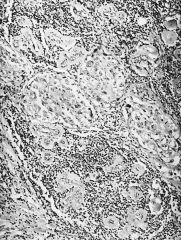
well circumscribed, composed of poorly differentiated cells in syncytia or large sheets, with prominent lymphoplasmacytic infiltrate, scant fibrous stroma, no glandular structures, minimal DCIS
Uncommon, <1% of invasive breast carcinomas |
Medullary carcinoma - Breast malignant
Slightly better prognosis than invasive ductal carcinoma NOS, even though high grade, aneuploid, ER/PR negative, p53 positive, high proliferation rates (1) indistinct cell borders (syncytial growth) making up 75% of tumor with large pleomorphic tumor cells containing large nuclei, prominent nucleoli, numerous mitotic figures; peripheral cells are more eosinophilic; (2) prominent lymphoplasmacytic infiltrate at periphery composed of T cells and IgA plasma cells; (3) pushing borders / well circumscribed |
|
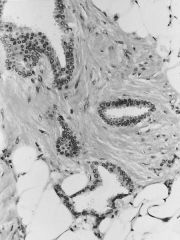
special type of breast carcinoma with favorable prognosis, composed of distinct well differentiated tubular structures (90%+ according to WHO) with open lumina, lined by a single layer of epithelial cells
|
Tubular carcinoma - Breast
Positive stains: ER, PR, E-cadherin (reduced) Negative stains: HER2 (AJCP 2006;126:55), p53, EGFR, myoepithelial markers - p63, CD10, smooth muscle actin, CK5/6 Molecular: usually diploid; 16q- (78% of tumors), 1q+ (50%), but fewer overall chromosomal changes and 17p- than ductal NOS |
|

special type of breast carcinoma with favorable prognosis, composed of distinct well differentiated tubular structures (90%+ according to WHO) with open lumina, lined by a single layer of epithelial cells
|
Tubular carcinoma - Breast
Positive stains: ER, PR, E-cadherin (reduced) Negative stains: HER2 (AJCP 2006;126:55), p53, EGFR, myoepithelial markers - p63, CD10, smooth muscle actin, CK5/6 Molecular: usually diploid; 16q- (78% of tumors), 1q+ (50%), but fewer overall chromosomal changes and 17p- than ductal NOS |
|
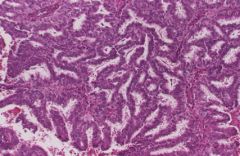
Rare; invasive and in-situ tumors together are 1-2% of breast carcinomas in women
Average age 63-67 years 5 year survival is 90%, better than invasive ductal NOS (although some of the papillary cases may, in fact, be in situ only) Invasive carcinoma can arise in papillomas |
Papillary carcinoma - invasive - Breast
|
|
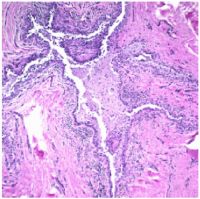
A 54-year-old multiparous woman presents with a painless, poorly defined subareolar mass, accompanied by thick, white nipple secretions. The histology of the lesion is shown (Fig. 12.1). Which of the following is TRUE of the lesion?
a. It is associated with cigarette smoking. b. The lesion is characterized by a dilatation of ducts, inspissation of breast secretions, and a marked periductal and interstitial chronic granulomatous inflammatory reaction. c. The periductal and interductal inflammation is manifested by heavy infiltrates of neutrophils. d. The mass is an intraductal papilloma. e. This lesion is not usually mistaken as carcinoma clinically. |
B.The lesion depicted in the image is mammary duct ectasia . The history is classic. The lesion is characterized by a dilatation of ducts, inspissation of breast secretions, and a marked periductal and interstitial chronic granulomatous inflammatory reaction. Smoking is associated with periductal mastitis. The infiltrate associated with periductal mastitis consists of lymphocytes and macrophages. Intraductal papillomas do not present with thick secretions. Duct ectasia is of clinical significance because it can be confused with carcinoma by palpation and on mammographic examination.
|
|
|
All of the following findings are associated with fibrocystic changes of the breast EXCEPT:
a. Cysts b. Apocrine metaplasia c. Fibrosis d. Atypical ductal hyperplasia e. Adenosis |
D. The histologic findings in fibrocystic breast changes are cyst formation, often with apocrine metaplasia, fibrosis, usually secondary to cyst rupture, and adenosis. These are all forms of nonproliferative breast changes. Atypical ductal hyperplasia is a form of proliferative breast disease and is not a component of fibrocystic changes.
|
|
|
The most common risk factors for breast cancer include all of the following EXCEPT:
a. Age b. Age at menarche c. Race d. Age at first live birth e. Second-degree relatives with breast cancer |
E. The most common risk factors for the development of breast carcinoma as identified by epidemiologic studies include age, age at menarche, age at first live birth, first-degree relatives with breast cancer, history of breast biopsies, and race. A history of second-degree relatives with breast cancer is not identified as a risk factor. Additional recognized risk factors include estrogen exposure, radiation exposure, carcinoma of the contralateral breast or endometrium, geographic influence, diet, obesity, exercise, breastfeeding, and environmental toxins.
|
|
|
All of the following findings are associated with fibrocystic changes of the breast EXCEPT:
a. Cysts b. Apocrine metaplasia c. Fibrosis d. Atypical ductal hyperplasia e. Adenosis |
D. The histologic findings in fibrocystic breast changes are cyst formation, often with apocrine metaplasia, fibrosis, usually secondary to cyst rupture, and adenosis. These are all forms of nonproliferative breast changes. Atypical ductal hyperplasia is a form of proliferative breast disease and is not a component of fibrocystic changes.
|
|
|
The most common risk factors for breast cancer include all of the following EXCEPT:
a. Age b. Age at menarche c. Race d. Age at first live birth e. Second-degree relatives with breast cancer |
E. The most common risk factors for the development of breast carcinoma as identified by epidemiologic studies include age, age at menarche, age at first live birth, first-degree relatives with breast cancer, history of breast biopsies, and race. A history of second-degree relatives with breast cancer is not identified as a risk factor. Additional recognized risk factors include estrogen exposure, radiation exposure, carcinoma of the contralateral breast or endometrium, geographic influence, diet, obesity, exercise, breastfeeding, and environmental toxins.
|
|

What is the diagnosis in these abdominal gonads removed from a 10-year-old girl (Fig. 12.21)?
|
The tumor shown in the image is a gonadoblastoma. It is composed of sharply defined tumor nests with primitive germ cells admixed with Sertoli and granulosa cells. Tumor calcification is usually present. Dysgerminoma is a germ cell tumor of the ovary that is analogous to seminoma in the testis. Sex cord tumor with annular tubules combines the features of a granulosa cell tumor with the growth pattern of Sertoli cells. Morphologically it contains simple and complex annular tubules containing eosinophilic, often calcified, hyaline bodies. Gynandroblastoma is a tumor that contains approximately equal components of granulosatheca cell and Sertoli-Leydig cell components. Rarely, the sex cord-stromal component can be overgrown by the Sertoli cell component, resulting in a Sertoli cell tumor.
|
|
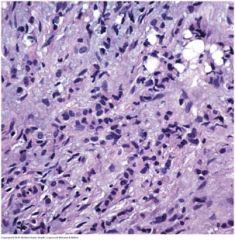
The lesion shown was excised from the breast of a 58-year-old woman (Fig. 12.3). Which of the following immunohistochemical markers will be most helpful in establishing the diagnosis?
a. Cytokeratin AE1/AE3 b. Epithelial membrane antigen (EMA) c. Gross cystic disease fluid protein-15 (GCDFP-15) d. E-cadherin e. Lactalbumin |
D. The lesion depicted in this figure is invasive lobular carcinoma , which is highlighted by tumor cells in a single-file pattern and a minimally desmoplastic stroma in many cases. Cytokeratin AE1/AE3, EMA, GCDFP-15, and lactalbumin are common to many lesions of the breast. E-cadherin distinguishes lobular carcinoma from other processes in the breast because of its negative staining pattern. Most cases of lobular carcinoma show a loss of chromosome 16q22.1, resulting in a loss of the E-cadherin gene.
|
|
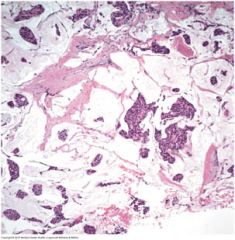
A 58-year-old woman presents with a wellcircumscribed breast mass. The histology is demonstrated (Fig. 12.4). Which of the following is true of this lesion?
a. Grossly, foci of hemorrhage are infrequent. b. This tumor has weak immunoreactivity for MUC2 and increased immunoreactivity for MUC1 when compared with ductal carcinoma not otherwise specified. c. The mucin in this lesion is extracellular and may be of acid or neutral type. d. Of these lesions, 75% show features consistent with endocrine differentiation. e. Grossly, these lesions are poorly defined. |
C. The lesion in the figure represents mucinous carcinoma. It is characterized histologically by small clusters of tumor cells floating in large pools of mucin as seen here. Foci of hemorrhage within these tumors are frequently seen. The tumor has strong cytoplasmic reactivity for MUC2 and decreased reactivity for MUC1 when compared with ductal carcinoma NOS. One quarter to one half of these tumors show endocrine differentiation consisting of argyrophilia, neuron specific enolase positivity, and dense core granules on electron microscopy. The mucin in the tumor is almost entirely extracellular and it may be of acid or neutral type. Grossly, these lesions tend to have sharply defined borders.
|
|
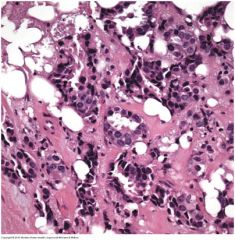
A 51-year-old woman presents with a 1-cm breast mass. The lesion was excised and the histology is shown. (Fig. 12.5) Which of the following is the best answer?
a. The lesion can be easily differentiated from radial scar and microglandular adenosis on microscopic examination. b. These lesions can be characterized by angulated glands, apical blebbing, and luminal calcifications. c. It is unusual for these tumors to be underdiagnosed as a benign process on fine needle aspiration biopsy. d. Metastases to axillary lymph nodes occur in 50% of cases and the prognosis is poor. e. This diagnosis is common, accounting for 35% to 40% of breast carcinoma diagnoses. |
A. The tumor in this image is an example of tubular carcinoma. The angulated shape of the glands and apical snouts are characteristic features of this lesion. Calcifications were noted elsewhere in the lesion. Mitotic figures are absent in these lesions and nuclear pleomorphism is scant. Because of the marked degree of cellular differentiation in these lesions, it is not at all unusual for them to be underdiagnosed as benign. Metastases to the axillary lymph nodes occur in only 10% of cases and the prognosis is excellent. Because of the well-differentiated nature of this lesion, radial scar and microglandular adenosis are important differential diagnostic considerations and are sometimes difficult to differentiate from tubular carcinoma. The diagnosis is relatively uncommon, accounting for a frequency of 1% to 3% in clinical practice.
|
|
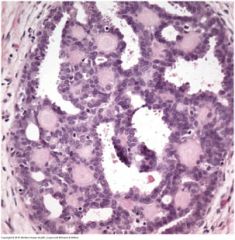
A 46-year-old woman has a lesion in association with an intraductal papilloma. The histology is shown (Fig. 12.6). Which of the following is true of this lesion?
a. This lesion is only seen in association with intraductal papilloma. b. This lesion may also be seen in salivary gland tumors. c. Carcinoma is not seen in association with these lesions in the breast. d. Ultrastructurally, collagen is not seen. e. These lesions are positive for Alcian blue. |
B.The histology represented here is that of collagenous spherulosis . It is characterized by the presence of intraluminal clusters of generally eosinophilic but sometimes basophilic collagen-rich spherules that seem to arise within the spaces between the epithelial and myoepithelial cells. The lesion can be seen in association with intraductal papilloma and sclerosing adenosis. Exceptionally, foci of lobular carcinoma in situ can involve this lesion. Collagen is seen ultrastructurally in association with basement membrane material and mineral deposition. Collagenous spherulosis can be seen in association with salivary gland tumors. Because this lesion does not contain any type of mucin, it would not be positive for Alcian blue.
|
|

A 66-year-old woman is diagnosed with the lesion shown in the photomicrograph (Fig. 12.7).Which of the following is true about this disease?
a. This invasive tumor does not exhibit the pattern of growth of a classical breast carcinoma. b. This lesion frequently shows apocrine differentiation, signet ring morphology and nuclear pleomorphism. c. E-cadherin immunostaining is frequently positive. d. Expression of p53 and HER-2/neu is low. |
B. This is an example of pleomorphic lobular carcinoma. It has the pattern of growth of a classical invasive lobular carcinoma complete with the single cell file pattern of growth but exhibits a marked degree of nuclear pleomorphism and abundant cytoplasm. It frequently shows apocrine metaplasia and focal signet ring morphology. Expression of p53 and HER2/ is very high. Lack of E-cadherin staining is in keeping with the lobular nature of the tumor.
|
|
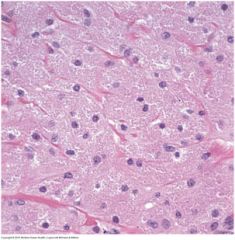
A 27-year-old woman presents with a breast mass that is excised. The histology is demonstrated (Fig. 12.8). Which of the following statements about this lesion is most correct?
a. It grossly simulates the appearance of invasive carcinoma. b. Tumors are on average 10 cm or more in greatest dimension. c. The tumor is aggressive and excision should be wide. d. The cytoplasm is negative for periodic acid Schiff (PAS) stain. e. The overwhelming majority of these cases are malignant. |
A. The histology shown is classic for granular cell tumor. The cells depicted contain innumerable fine cytoplasmic granules in addition to some larger cytoplasmic granules. The tumors tend to be small and are uncommonly larger than 5 cm. The tumor exhibits benign behavior and local excision is the usual treatment. The large cytoplasmic granules are positive for PAS. It characteristically resembles carcinoma both grossly and clinically, which leads to excision in most cases. Granular cell tumors are benign neoplasms, which carry an excellent prognosis.
|
|

|
Columnar cell change
This is characterized by dilation of the TDLUs, which become lined by columnar cells that usually display cytoplasmic projections at the apex of the cells, termed apical snouts; intraluminal secretions are also present |
|

A 14-year-old boy developed a nodule below the left nipple. The lesion is excised. The histology is demonstrated (Fig. 12.9). Which of the following statements about the lesion is correct?
a. The lesion can be the result of the hormonal changes of puberty or hormone-secreting tumors. b. Breast carcinoma is not in the differential diagnosis of this lesion. c. Epithelial hyperplasia and stromal edema are absent. d. Histologically similar changes are not seen in the female breast. e. Hypertrophy of the stromal elements, but not the glandular elements, are seen in this lesion. |
gynecomastia is defined as the enlargement of the male breast which results from hypertrophy and hyperplasia of both the glandular and stromal components. The image shows the characteristic epithelial proliferation surrounded by a hypocellular myxoid halo. It can be a result of the hormonal changes of puberty or of a hormonesecreting tumor. Breast carcinoma is always in the differential diagnosis of this lesion. Histologically similar changes have been reported to occur in the female breast.
|
|
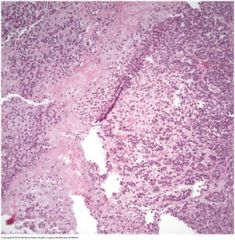
A perimenopausal woman discovered a large breast mass that was excised. The histology is shown in the figure (Fig. 12.10). Which of the following statements about this lesion is correct?
a. These lesions acquire vimentin immunohistochemical reactivity but lose reactivity with epithelial markers. b. Subtypes include spindle cell carcinoma, carcinoma with osteoclast-like giant cells, and carcinomas with neuroendocrine features. c. The behavior of this lesion seems to be more aggressive than that of ordinary invasive ductal carcinoma. d. The size of the neoplasm at excision is a poor predictor of survival. e. The sarcomatoid variant of this neoplasm is poorly circumscribed. |
C. The lesion shown is an example of metaplastic carcinoma. It is a ductal carcinoma in which heterologous components are the predominant feature of the lesion (such as the cartilaginous elements seen here). These lesions tend to acquire vimentin positivity in keeping with the mesenchymal elements seen, but occasionally maintain their epithelial staining pattern as well. Subtypes include sarcomatoid carcinoma, spindle cell carcinoma, and carcinoma with osteoclast-like giant cells. The size of the neoplasm at excision is one of the best predictors of survival. These tumors appear to be more aggressive than ordinary invasive ductal carcinomas. The sarcomatoid variant is characteristically well circumscribed.
|
|
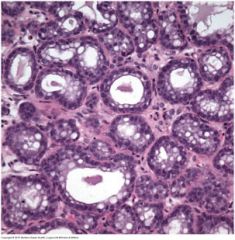
A 31-year-old woman in her first pregnancy experienced discharge from a mass in the vulva. The lesion was excised and the histology is shown (Fig. 12.11). Which of the following is most consistent with this lesion?
a. This lesion is a localized focus of hyperplasia in ectopic breast tissue. b. The cut surface of the lesion is white without necrotic changes. c. This lesion may be seen during pregnancy but not during the puerperium. d. Similar changes are not seen in preexisting fibroadenomas. e. These lesions are usually poorly delineated at the time of excision. |
A.The lesion depicted is a lactating adenoma. Microscopically, proliferated glands are lined by cuboidal cells which actively secrete milk. This lesion may be seen in the lactating breast as well as in ectopic breast tissue in the axilla, chest wall, or vulva. It is a localized focus of hyperplastic tissue in the lactating breast. It may be seen in pregnancy and in the puerperium. Grossly, these lesions are generally well delineated at the time of excision. The cut surface is gray or tan and necrotic changes are frequent. Lactating adenomas should be distinguished from the proliferative and secretory changes brought on by pregnancy in a preexisting fibroadenoma.
|
|
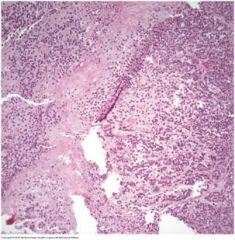
A perimenopausal woman discovered a large breast mass that was excised. The histology is shown in the figure (Fig. 12.10). Which of the following statements about this lesion is correct?
a. These lesions acquire vimentin immunohistochemical reactivity but lose reactivity with epithelial markers. b. Subtypes include spindle cell carcinoma, carcinoma with osteoclast-like giant cells, and carcinomas with neuroendocrine features. c. The behavior of this lesion seems to be more aggressive than that of ordinary invasive ductal carcinoma. d. The size of the neoplasm at excision is a poor predictor of survival. e. The sarcomatoid variant of this neoplasm is poorly circumscribed. |
C. The lesion shown is an example of metaplastic carcinoma. It is a ductal carcinoma in which heterologous components are the predominant feature of the lesion (such as the cartilaginous elements seen here). These lesions tend to acquire vimentin positivity in keeping with the mesenchymal elements seen, but occasionally maintain their epithelial staining pattern as well. Subtypes include sarcomatoid carcinoma, spindle cell carcinoma, and carcinoma with osteoclast-like giant cells. The size of the neoplasm at excision is one of the best predictors of survival. These tumors appear to be more aggressive than ordinary invasive ductal carcinomas. The sarcomatoid variant is characteristically well circumscribed.
|
|
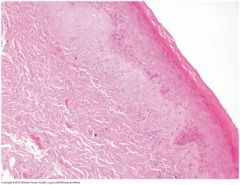
A 7-year-old girl presents with a white, keyhole-shaped lesion involving the vulva. A biopsy is performed and the histology of the lesion is shown (Fig. 12.12). Which of the following statements is most consistent with this lesion?
a. The vulvar region presents the least common location of this lesion in children. b. Microscopically, the overlying epidermis of this lesion can be hyperplastic. c. The minimal histologic criteria for the microscopic diagnosis of this lesion are the presence of a vacuolar interface reaction pattern in conjunction with dermal sclerosis of any thickness. d. Rare cases of carcinoma associated with this lesion show an underexpression of p53. e. These lesions are never seen in association with squamous cell carcinoma of the vulva. |
C. The lesion depicted here is lichen sclerosus . Microscopically, a thick edematous, hypocellular layer (dermis) is seen with a characteristically atrophic epidermis. The vulva is the most common location of affliction in children. In the rare instances where carcinoma has been associated with lichen sclerosus, there is an association with overexpression of p53. The minimal microscopic criteria for this lesion are the presence of a vacuolar interface reaction pattern in conjunction with dermal sclerosis of any thickness.
|
|

A 17-year-old girl presents with vaginal bleeding distinct from her menses. On gynecologic examination, a mass is identified along the lateral wall of the upper vagina and is biopsied (Fig. 12.13). All of the following are true of this lesion EXCEPT:
a. This diagnosis is extremely rare before the age of 12 and after the age of 30; however, a small number of cases occur at the age of 70. b. All cases are linked to perinatal exposure of diethylstilbestrol (DES). c. Microscopically, there are tubules and cysts lined by clear cells alternating with more solid areas and papillary formations as well as hobnail-shaped cells protruding into glandular lumens. d. The immunohistochemical profile of these tumors is characterized by consistent positivity for CK7, Cam 5.2, 34βE12, CEA, and CA-125. e. These tumors have ultrastructural characteristics much like lesions of similar type that occur in the endometrium and ovary of older women. |
B.The lesion shown is clear cell carcinoma of the vagina. The figure shows prominent clear cell features. The average age of diagnosis is 17 years and is extremely rare before age 12 and after age 30. A small second peak is known to occur at 70 years. Common microscopic features are tubules and cysts lined by clear cells alternating with more solid areas and papillary formations as well as hobnail-shaped cells protruding into glandular lumens. CK7, Cam 5.2, 34βE12, CEA, and CA-125 are consistently positive in these lesions. These lesions share similar ultrastructural characteristics with the clear cell carcinomas of the ovary and endometrium seen in older women. Only two thirds of cases are associated with perinatal exposure to diethylstilbestrol (DES), a nonsteroidal estrogen formerly used to prevent miscarriages and other obstetric complications.
|
|
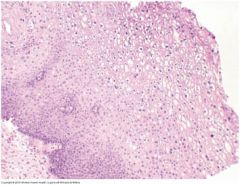
An 18-year-old sexually active woman had a Pap smear. Based on the results of the Pap smear, a biopsy was performed and the histology is shown (Fig. 12.14). Which of the following is true about her lesion?
a. Her lesion should be described as low-grade squamous intraepithelial dysplasia or cervical intraepithelial neoplasia I. b. Her lesion should be described as high-grade squamous intraepithelial lesion or cervical intraepithelial lesion II. c. HPV types 6 and 11 are usually responsible for her lesion. d. Koilocytic atypia is not a feature of this diagnosis. e. A radical hysterectomy will be needed to resolve this lesion as it will not resolve on its own. |
A.The lesion depicted is low grade squamous intraepithelial lesion or cervical intraepithelial neoplasia I. The figure depicts cells with irregular nuclear membranes, koilocytic atypia, and binucleate cells. Therefore, koilocytic atypia has some bearing in this diagnosis. Squamous intraepithelial lesions are caused by high-risk HPV, not low-risk types like HPV 6 and 11. Low-grade squamous intraepithelial lesions resolve spontaneously in a large number of patients and whether all patients with low-grade lesions need therapy is a controversial issue.
|
|
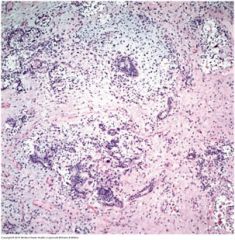
A 61-year-old woman presented with the lesion shown in the image (Fig. 12.17). Which of the following statements is true of this lesion?
a. Microscopically, this tumor is characterized by an admixture of sarcomatous and carcinomatous areas, resulting in a biphasic appearance. b. This is a low-grade neoplasm that is well differentiated. c. Heterologous mesenchymal elements such as fat, cartilage, or skeletal muscle are not commonly seen. d. These tumors are practically always seen in premenopausal women. e. Cytokeratins are positive in the carcinomatous areas, but never in the sarcomatous elements. |
A. This image shows the heterologous type of MMMT. These are also known as carcinosarcomas. The image shows a carcinomatous component with adjacent cartilage. These are poorly differentiated, high-grade neoplasms that are almost always seen in postmenopausal women. Heterologous elements, such as fat, skeletal muscle, and cartilage are fairly commonly seen in these tumors. They stain positively for cytokeratin not only in the carcinomatous component of the tumor but also in the sarcomatous component in over half of cases. These tumors are characterized microscopically by an admixture of carcinomatous and sarcomatous elements, resulting in a biphasic appearance.
|
|
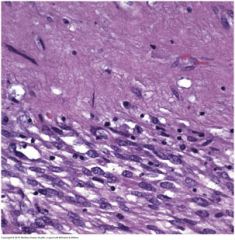
All of the following immunohistochemical markers are positive in the myometrial lesion seen in the image (Fig. 12.18) EXCEPT:
a. Smooth muscle actin b. H-caldesmon c. Vimentin d. CD-10 e. Cam 5.2 |
D. The lesion depicted here is a leiomyosarcoma, illustrated here by a smooth muscle background with coagulative necrosis and mitoses. Smooth muscle actin, h-caldesmon, vimentin, and Cam 5.2 are positive in leiomyosarcomas. CD-10, while positive in endometrial stromal sarcomas, is negative in leiomyosarcomas.
|
|
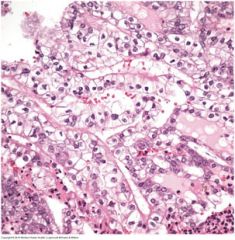
A postmenopausal woman was noted to have an ovarian mass on ultrasound. The mass was resected and a representative image is shown (Fig. 12.20). This tumor is expected to be negative for which of the following cytokeratins?
a. CK20 b. CK7 c. CK5/6 d. Cam 5.2 e. 34βE12 |
A.This is an example of clear cell adenocarcinoma . It is characterized histologically by large tumor cells with clear cytoplasm which often contains glycogen, mucin, and fat. Some of the nuclei protrude into the lumina producing the effect called hobnailing. Many different cytokeratins, including CK7, CK5/6, Cam 5.2, and 34βE12, are positive in these lesions. CK20 is consistently negative.
|
|
|
replacement of epithelium by up to 5 layers of mildly atypical cells, presumably neoplastic
flat ductal intraepithelial neoplasia 1 (DIN1a) |
Flat epithelial atypia of breast
Positive stains: CK19, ER, PR Negative stains: CK5, CK6, 34betaE12 |
|

|
Flat epithelial atypia: columnar cell change with atypia. (a) This terminal duct lobular unit shows variably dilated acini, many of which contain intraluminal secretions and calcifications. Most acini are lined by only one or two layers of columnar epithelial cells, many of which show prominent apical cytoplasmic snouts (hematoxylin & eosin, original magnification 10×). (b) The columnar epithelial cells lining the acini show cytologic atypia, characterized by enlarged, monotonous nuclei; the nuclear/cytoplasmic ratio is increased. Nucleoli are evident in some of the nuclei
|
|
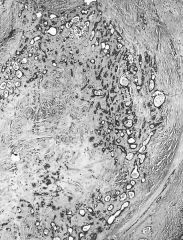
well circumscribed, benign glandular proliferation in part within a duct lumen
Also called sclerosing papilloma |
Ductal adenoma of breast
Positive stains: tubular luminal cells - keratin; tubular basal cells - S100, actin, p63; basement membrane - laminin, type IV collagen; stromal spindle cells (myofibroblasts) - actin and vimentin |
|
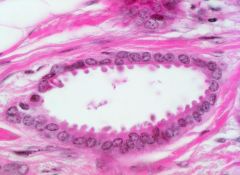
Positive stains: ER, PR, E-cadherin (reduced)
Negative stains: HER2 (AJCP 2006;126:55), p53, EGFR, myoepithelial markers - p63, CD10, smooth muscle actin, CK5/6 Molecular: usually diploid; 16q- (78% of tumors), 1q+ (50%), but fewer overall chromosomal changes and 17p- than ductal NOS |
tubular carcinoma
Invasive tubule lacking a basal membrane and a myoepithelial layer. |
|
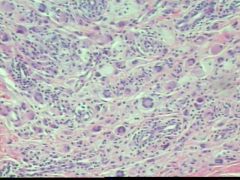
Also called nevoxanthoendothelioma
Benign histiocytic disorder of infants and children; 15% occur in adults (usually young) |
Juvenile xanthogranuloma of breast
Positive stains: Touton giant cells and histiocytes - CD68, HAM56, Factor XIIIa Negative stains: Touton giant cells and histiocytes - S100 and CD1a |
|
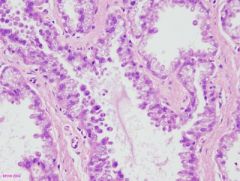
Usually during or shortly after pregnancy
Resembles fibroadenoma or tubular adenoma with lactational change microscopically |

Lactating adenoma of breast
|
|
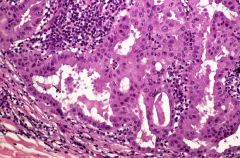
|
Ductal carcinoma in situ, high grade, apocrine type.
The cells have strongly eosinophilic, finely granular cytoplasm. Some luminal snouting is evident. |

